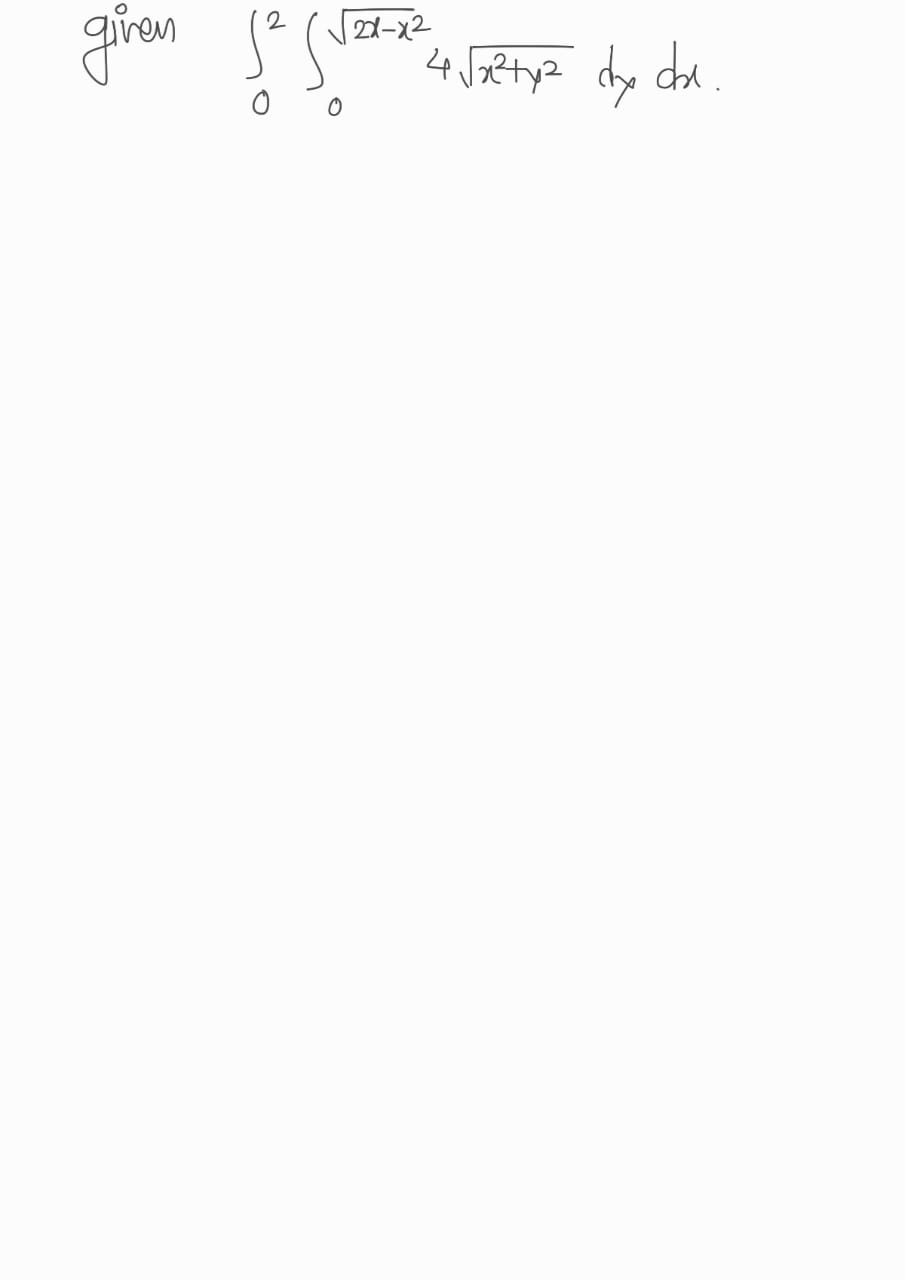Consider the following. A = Convert the iterated integral to polar coordinates. A B S^L. ( Jo Jo B = √2x - x 1² √2²-²4. Jo || 472 4r 4√x² + y² dy dx X Evaluate the iterated integral. dr de 4
Consider the following. A = Convert the iterated integral to polar coordinates. A B S^L. ( Jo Jo B = √2x - x 1² √2²-²4. Jo || 472 4r 4√x² + y² dy dx X Evaluate the iterated integral. dr de 4
Calculus: Early Transcendentals
8th Edition
ISBN:9781285741550
Author:James Stewart
Publisher:James Stewart
Chapter1: Functions And Models
Section: Chapter Questions
Problem 1RCC: (a) What is a function? What are its domain and range? (b) What is the graph of a function? (c) How...
Related questions
Question
![**Consider the following:**
\[ \int_{0}^{2} \int_{0}^{\sqrt{2x-x^2}} 4 \sqrt{x^2 + y^2} \, dy \, dx \]
**Convert the iterated integral to polar coordinates:**
\[ \int_{0}^{A} \int_{0}^{B} \left(4r^2\right) \, dr \, d\theta \]
- **A =** [Input field] (Incorrect, indicated with a red "X")
- **B =** [Input field] (Incorrect, indicated with a red "X")
**Evaluate the iterated integral.**
- [Input field]
**Need Help?** [Button: "Read It"]
[Button: "Submit Answer"]
Note: The incorrect inputs for \(A\) and \(B\) are marked with a red "X."
### Explanation:
To convert the given integral to polar coordinates, we need to express the Cartesian coordinates \( (x, y) \) in terms of polar coordinates \( (r, \theta) \). The transformation involves:
- \( x = r \cos \theta \)
- \( y = r \sin \theta \)
- The Jacobian of transformation \( \frac{\partial(x,y)}{\partial(r,\theta)} = r \).
This results in the double integral over polar coordinates for \( r \) and \( \theta \). The function \( \sqrt{x^2 + y^2} \) becomes \( r \) in polar coordinates. Thus, we integrate from \( r = 0 \) to the boundary in terms of \( \theta \).](/v2/_next/image?url=https%3A%2F%2Fcontent.bartleby.com%2Fqna-images%2Fquestion%2F04750898-40b6-4507-9bb8-e18bccce9e61%2F95787728-4bdd-4ef9-9e16-91377b5802d4%2F6wpyw2_processed.jpeg&w=3840&q=75)
Transcribed Image Text:**Consider the following:**
\[ \int_{0}^{2} \int_{0}^{\sqrt{2x-x^2}} 4 \sqrt{x^2 + y^2} \, dy \, dx \]
**Convert the iterated integral to polar coordinates:**
\[ \int_{0}^{A} \int_{0}^{B} \left(4r^2\right) \, dr \, d\theta \]
- **A =** [Input field] (Incorrect, indicated with a red "X")
- **B =** [Input field] (Incorrect, indicated with a red "X")
**Evaluate the iterated integral.**
- [Input field]
**Need Help?** [Button: "Read It"]
[Button: "Submit Answer"]
Note: The incorrect inputs for \(A\) and \(B\) are marked with a red "X."
### Explanation:
To convert the given integral to polar coordinates, we need to express the Cartesian coordinates \( (x, y) \) in terms of polar coordinates \( (r, \theta) \). The transformation involves:
- \( x = r \cos \theta \)
- \( y = r \sin \theta \)
- The Jacobian of transformation \( \frac{\partial(x,y)}{\partial(r,\theta)} = r \).
This results in the double integral over polar coordinates for \( r \) and \( \theta \). The function \( \sqrt{x^2 + y^2} \) becomes \( r \) in polar coordinates. Thus, we integrate from \( r = 0 \) to the boundary in terms of \( \theta \).
Expert Solution
Step 1: Given

Step by step
Solved in 5 steps with 4 images

Recommended textbooks for you

Calculus: Early Transcendentals
Calculus
ISBN:
9781285741550
Author:
James Stewart
Publisher:
Cengage Learning

Thomas' Calculus (14th Edition)
Calculus
ISBN:
9780134438986
Author:
Joel R. Hass, Christopher E. Heil, Maurice D. Weir
Publisher:
PEARSON

Calculus: Early Transcendentals (3rd Edition)
Calculus
ISBN:
9780134763644
Author:
William L. Briggs, Lyle Cochran, Bernard Gillett, Eric Schulz
Publisher:
PEARSON

Calculus: Early Transcendentals
Calculus
ISBN:
9781285741550
Author:
James Stewart
Publisher:
Cengage Learning

Thomas' Calculus (14th Edition)
Calculus
ISBN:
9780134438986
Author:
Joel R. Hass, Christopher E. Heil, Maurice D. Weir
Publisher:
PEARSON

Calculus: Early Transcendentals (3rd Edition)
Calculus
ISBN:
9780134763644
Author:
William L. Briggs, Lyle Cochran, Bernard Gillett, Eric Schulz
Publisher:
PEARSON

Calculus: Early Transcendentals
Calculus
ISBN:
9781319050740
Author:
Jon Rogawski, Colin Adams, Robert Franzosa
Publisher:
W. H. Freeman


Calculus: Early Transcendental Functions
Calculus
ISBN:
9781337552516
Author:
Ron Larson, Bruce H. Edwards
Publisher:
Cengage Learning